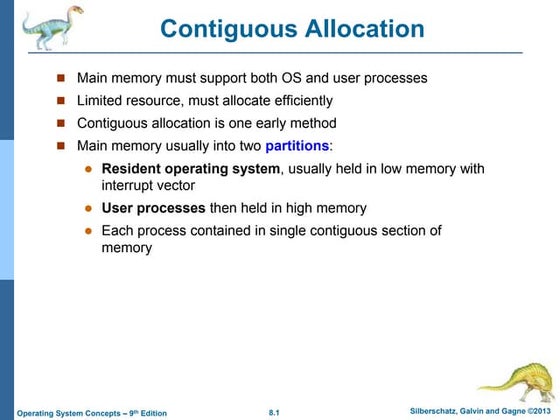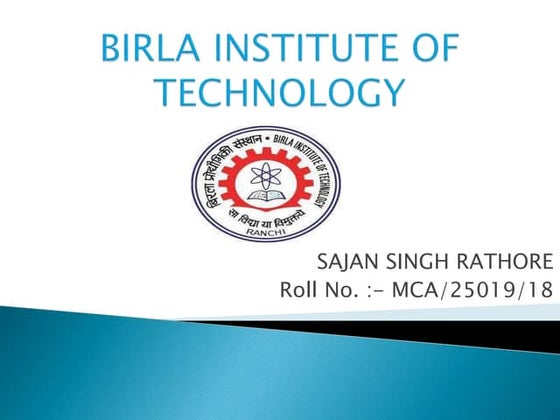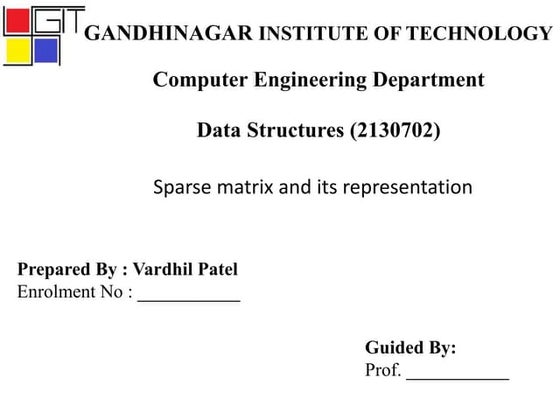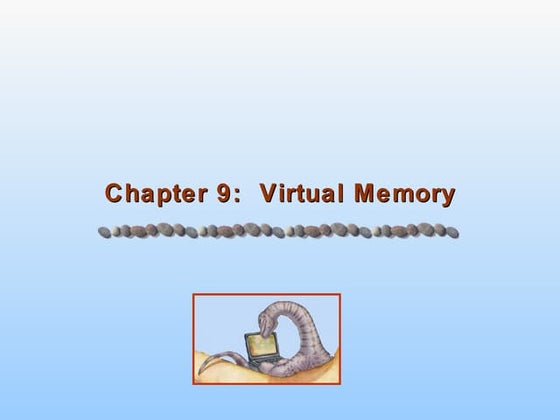Page Replacement Algorithms
Download as PPTX, PDF4 likes8,054 views
The document discusses various page replacement algorithms used in computer operating systems. It describes paging, which is a memory management technique that moves data between main memory and secondary storage. When a program requests a page that is not currently in memory, it causes a page fault. Page replacement algorithms determine which memory page to remove to allocate space for the new page. Common algorithms discussed include clock, LRU, NRU, and ARC. The ARC algorithm improves on LRU by maintaining two lists (T1 and T2) to track recently and frequently used pages, along with ghost lists (B1 and B2) of recently evicted pages.
1 of 9
Downloaded 196 times








![...[ B1 <-[ T1 <-!-> T2 ]-> B2 ] . ….
[ ……………. . . . [ . . . . . . ! . .^. …………...... ] …… . . . ]
[ fixed cache size (c) ]](https://image.slidesharecdn.com/pagereplacementalgorithms-13429337437366-phpapp02-120722001625-phpapp02/85/Page-Replacement-Algorithms-9-320.jpg)
Recommended
Page replacement



Page replacementsashi799
Ěý
This document discusses various page replacement algorithms used in operating systems. It describes FIFO, optimal, LRU, LRU approximation algorithms like additional reference bits, second chance, and enhanced second chance algorithms. It also discusses counting based algorithms and page buffering algorithms. The document compares different algorithms and discusses concepts like page faults, frames, and Belady's anomaly.Contiguous Memory Allocation.ppt



Contiguous Memory Allocation.pptinfomerlin
Ěý
Contiguous allocation is an early method for allocating main memory between the operating system and user processes. Each process is contained within a single contiguous section of memory. Relocation and limit registers are used to protect processes from each other and allow transient changes to the operating system. Multiple-partition allocation allocates variable sized partitions to processes out of memory holes. Storage allocation approaches like first-fit and best-fit are used to allocate partitions from the holes. Fragmentation can occur both externally and internally, taking up space that cannot be used.B trees in Data Structure



B trees in Data StructureAnuj Modi
Ěý
B-Trees are tree data structures used to store data on disk storage. They allow for efficient retrieval of data compared to binary trees when using disk storage due to reduced height. B-Trees group data into nodes that can have multiple children, reducing the height needed compared to binary trees. Keys are inserted by adding to leaf nodes or splitting nodes and promoting middle keys. Deletion involves removing from leaf nodes, borrowing/promoting keys, or joining nodes.Presentation on Segmentation



Presentation on SegmentationPriyanka bisht
Ěý
In this ppt the segmentation architecture ,advantages,working, the process and how it is used in the memory of the computer system.Concurrency Control Techniques



Concurrency Control TechniquesRaj vardhan
Ěý
The document discusses various concurrency control techniques used in database management systems to ensure transaction isolation. It covers locking techniques like two-phase locking and timestamp ordering. Locking involves associating locks like read/write locks with data items. The two-phase locking protocol defines rules for acquiring and releasing locks in two distinct phases. Timestamp ordering assigns unique timestamps to transactions and ensures conflicting operations are executed based on timestamp order to guarantee serializability.41 page replacement fifo



41 page replacement fifomyrajendra
Ěý
This document discusses storage management and page replacement algorithms. It begins with an introduction to page replacement and mentions FIFO as a page replacement algorithm. It then provides more details on concepts related to page replacement such as page faults, free frames, and the need for page replacement algorithms. The rest of the document focuses on explaining the FIFO page replacement algorithm through examples and diagrams. It also discusses disadvantages of FIFO and the concept of Belady's Anomaly where increasing the number of page frames can paradoxically increase page faults.Demand paging



Demand pagingTrinity Dwarka
Ěý
Virtual Memory
• Copy-on-Write
• Page Replacement
• Allocation of Frames
• Thrashing
• Operating-System Examples
Background
Page Table When Some Pages
Are Not in Main Memory
Steps in Handling a Page Fault
Stack



StackSeema Sharma
Ěý
This document discusses stacks and their applications. It defines a stack as a Last In First Out (LIFO) data structure where newly added items are placed on top. The core stack operations of PUSH, POP, and PEEK are described. An array implementation of stacks is presented and animations demonstrate push and pop operations. Applications of stacks like checking for balanced braces, converting infix to postfix notation, and postfix calculators are explained with examples. Pseudocode provides an algorithm for infix to postfix conversion using a stack.Page replacement algorithms



Page replacement algorithmssangrampatil81
Ěý
This document discusses different page replacement algorithms used in operating systems. It begins by explaining the basic concept of page replacement that occurs when memory is full and a page fault happens. It then describes several common page replacement algorithms: FIFO, Optimal, LRU, LRU approximations using reference bits, and Second Chance. The key aspects of each algorithm are summarized, such as FIFO replacing the oldest page, Optimal replacing the page not used for longest time, and LRU approximating this by tracking recently used pages. The document provides an overview of page replacement techniques in computer systems.FUNCTION DEPENDENCY AND TYPES & EXAMPLE



FUNCTION DEPENDENCY AND TYPES & EXAMPLEVraj Patel
Ěý
Functional dependency defines a relationship between attributes in a table where a set of attributes determine another attribute. There are different types of functional dependencies including trivial, non-trivial, multivalued, and transitive. An example given is a student table with attributes Stu_Id, Stu_Name, Stu_Age which has the functional dependency of Stu_Id->Stu_Name since the student ID uniquely identifies the student name.Dbms architecture



Dbms architectureShubham Dwivedi
Ěý
Dbms
architecture
Three level architecture is also called ANSI/SPARC architecture or three schema architecture
This framework is used for describing the structure of specific database systems (small systems may not support all aspects of the architecture)
In this architecture the database schemas can be defined at three levels explained in next slideStacks in c++



Stacks in c++Vineeta Garg
Ěý
The document discusses stacks in C++. It defines a stack as a data structure that follows LIFO (Last In First Out) principle where the last element added is the first to be removed. Stacks can be implemented using arrays or linked lists. The key operations on a stack are push which adds an element and pop which removes an element. Example applications of stacks include function call stacks, converting infix to postfix notation, and reversing arrays.BINARY TREE REPRESENTATION.ppt



BINARY TREE REPRESENTATION.pptSeethaDinesh
Ěý
Binary trees are a non-linear data structure where each node has at most two children, used to represent hierarchical relationships, with nodes connected through parent-child links and traversed through preorder, inorder, and postorder methods; they can be represented through arrays or linked lists and support common operations like search, insert, and delete through comparing node values and restructuring child pointers.INTRODUCTION TO ARTIFICIAL INTELLIGENCE



INTRODUCTION TO ARTIFICIAL INTELLIGENCEravi021
Ěý
Artificial Intelligence (AI) - History And Foundation, AI Techniques, Problem Solving With AI Models, Data Acquisition And Learning Aspects In AI.Paging and segmentation



Paging and segmentationPiyush Rochwani
Ěý
This document summarizes and compares paging and segmentation, two common memory management techniques. Paging divides physical memory into fixed-size frames and logical memory into same-sized pages. It maps pages to frames using a page table. Segmentation divides logical memory into variable-sized segments and uses a segment table to map segment numbers to physical addresses. Paging avoids external fragmentation but can cause internal fragmentation, while segmentation avoids internal fragmentation but can cause external fragmentation. Both approaches separate logical and physical address spaces but represent different models of how a process views memory.Page replacement algorithms



Page replacement algorithmsPiyush Rochwani
Ěý
This document discusses various page replacement algorithms used in operating systems. It begins with definitions of paging and page replacement in virtual memory systems. There are then overviews of 12 different page replacement algorithms including FIFO, optimal, LRU, NRU, NFU, second chance, clock, and random. The goal of page replacement algorithms is to minimize page faults. The document provides examples and analyses of how each algorithm approaches replacing pages in memory.Page replacement algorithm



Page replacement algorithmLavina Gehlot
Ěý
This is a short presentation of a BCA subject OPERATING SYSTEM of ch.- Memory Management on topic "page replacement algorithm"..
Thank youBinomial heap presentation



Binomial heap presentationHafsa.Naseem
Ěý
Binomial heaps are a data structure that supports union operations more efficiently than binary heaps. A binomial heap is made up of binomial trees, which are ordered trees built recursively. A binomial heap satisfies properties where no two trees are the same size, each node has a key, and children have smaller keys than their parents. Operations like finding the minimum, inserting, deleting, and uniting heaps take O(log n) time due to the heap being made up of O(log n) trees.Sorting algorithms



Sorting algorithmsTrupti Agrawal
Ěý
The document discusses various sorting algorithms. It describes how sorting algorithms arrange elements of a list in a certain order. Efficient sorting is important as a subroutine for algorithms that require sorted input, such as search and merge algorithms. Common sorting algorithms covered include insertion sort, selection sort, bubble sort, merge sort, and quicksort. Quicksort is highlighted as an efficient divide and conquer algorithm that recursively partitions elements around a pivot point.Reusibility vs Extensibility in OOAD



Reusibility vs Extensibility in OOADShivani Kapoor
Ěý
GIve differences in 4 unique and basic terms of UML, classification , definitions ,frameworks. understandable through diagrams. Some similarities / Trade-off are also for more detailed knowledge.Priority Queue in Data Structure



Priority Queue in Data StructureMeghaj Mallick
Ěý
This document discusses priority queues. It defines a priority queue as a queue where insertion and deletion are based on some priority property. Items with higher priority are removed before lower priority items. There are two main types: ascending priority queues remove the smallest item, while descending priority queues remove the largest item. Priority queues are useful for scheduling jobs in operating systems, where real-time jobs have highest priority and are scheduled first. They are also used in network communication to manage limited bandwidth.Timestamp protocols



Timestamp protocolsPrashant Saini
Ěý
This document provides an overview of timestamp protocols in database management systems. It discusses how timestamps are generated and used to order transactions. The basic timestamp ordering protocol checks timestamps on read and write operations to ensure serializability. Strict timestamp ordering delays some transactions to ensure schedules are both serializable and strict. Multiversion timestamp ordering uses multiple versions of data items to allow reads to always succeed while maintaining serializability.Sparse matrix and its representation data structure



Sparse matrix and its representation data structureVardhil Patel
Ěý
The document discusses sparse matrices and their efficient representation. It defines a sparse matrix as one with very few non-zero elements, so representing it as a standard 2D array wastes space storing many zero values. More efficient representations of sparse matrices include storing only the non-zero elements and their indices in a triplet format, or using a linked list structure with one list per row containing (column, value) node pairs. Examples of each approach are provided.Operating System - Types Of Operating System Unit-1



Operating System - Types Of Operating System Unit-1abhinav baba
Ěý
In This şÝşÝߣ There is Operating System And it's types ( Types of operating system)
Batch Operating System
Network Operating System
Time Sharing Operating System
Real Time Operating System
Distributed Operating SystemB tree



B treeRajendran
Ěý
The document discusses B-trees, which are self-balancing search trees used to store large datasets. B-trees overcome limitations of storing data in memory by keeping the tree partially balanced and stored on disk. The document outlines properties of B-trees including that internal nodes must have a minimum number of children based on the tree's order, and that inserting data may cause nodes to split and keys to propagate up the tree to maintain balance.Chapter 9 - Virtual Memory



Chapter 9 - Virtual MemoryWayne Jones Jnr
Ěý
Background
Demand Paging
Copy-on-Write
Page Replacement
Allocation of Frames
Thrashing
Memory-Mapped Files
Allocating Kernel Memory
Other Considerations
Operating-System ExamplesPage Replacement



Page Replacementchandinisanz
Ěý
Virtual memory management uses demand paging to load pages into memory only when needed. When memory is full and a new page is needed, a page must be replaced. Common replacement algorithms include FIFO, LRU, and Clock, with LRU and Clock approximating optimal replacement by selecting the least recently used page. Page buffering keeps replaced pages in memory briefly to avoid premature replacement.Queue data structure



Queue data structureanooppjoseph
Ěý
A queue is a non-primitive linear data structure that follows the FIFO (first-in, first-out) principle. Elements are added to the rear of the queue and removed from the front. Common operations on a queue include insertion (enqueue) and deletion (dequeue). Queues have many real-world applications like waiting in lines and job scheduling. They can be represented using arrays or linked lists.Pagereplacement algorithm(computional concept)



Pagereplacement algorithm(computional concept)Siddhi Viradiya
Ěý
This document discusses page replacement techniques used in computer memory management. It covers the need for page replacement due to limited physical memory frames. The basic page replacement process is described as finding the desired page, a free frame if available, or using a replacement algorithm to select a victim frame if necessary. Common replacement algorithms like FIFO, optimal, and LRU are introduced along with their advantages and drawbacks. Belady's anomaly is also mentioned, which is when page fault rate can paradoxically increase as the number of available frames increases under FIFO replacement.Virtual memory and page replacement algorithm



Virtual memory and page replacement algorithmMuhammad Mansoor Ul Haq
Ěý
It is basically about the virtual memory and have details about different algorithms that how page replacement occour More Related Content
What's hot (20)
Page replacement algorithms



Page replacement algorithmssangrampatil81
Ěý
This document discusses different page replacement algorithms used in operating systems. It begins by explaining the basic concept of page replacement that occurs when memory is full and a page fault happens. It then describes several common page replacement algorithms: FIFO, Optimal, LRU, LRU approximations using reference bits, and Second Chance. The key aspects of each algorithm are summarized, such as FIFO replacing the oldest page, Optimal replacing the page not used for longest time, and LRU approximating this by tracking recently used pages. The document provides an overview of page replacement techniques in computer systems.FUNCTION DEPENDENCY AND TYPES & EXAMPLE



FUNCTION DEPENDENCY AND TYPES & EXAMPLEVraj Patel
Ěý
Functional dependency defines a relationship between attributes in a table where a set of attributes determine another attribute. There are different types of functional dependencies including trivial, non-trivial, multivalued, and transitive. An example given is a student table with attributes Stu_Id, Stu_Name, Stu_Age which has the functional dependency of Stu_Id->Stu_Name since the student ID uniquely identifies the student name.Dbms architecture



Dbms architectureShubham Dwivedi
Ěý
Dbms
architecture
Three level architecture is also called ANSI/SPARC architecture or three schema architecture
This framework is used for describing the structure of specific database systems (small systems may not support all aspects of the architecture)
In this architecture the database schemas can be defined at three levels explained in next slideStacks in c++



Stacks in c++Vineeta Garg
Ěý
The document discusses stacks in C++. It defines a stack as a data structure that follows LIFO (Last In First Out) principle where the last element added is the first to be removed. Stacks can be implemented using arrays or linked lists. The key operations on a stack are push which adds an element and pop which removes an element. Example applications of stacks include function call stacks, converting infix to postfix notation, and reversing arrays.BINARY TREE REPRESENTATION.ppt



BINARY TREE REPRESENTATION.pptSeethaDinesh
Ěý
Binary trees are a non-linear data structure where each node has at most two children, used to represent hierarchical relationships, with nodes connected through parent-child links and traversed through preorder, inorder, and postorder methods; they can be represented through arrays or linked lists and support common operations like search, insert, and delete through comparing node values and restructuring child pointers.INTRODUCTION TO ARTIFICIAL INTELLIGENCE



INTRODUCTION TO ARTIFICIAL INTELLIGENCEravi021
Ěý
Artificial Intelligence (AI) - History And Foundation, AI Techniques, Problem Solving With AI Models, Data Acquisition And Learning Aspects In AI.Paging and segmentation



Paging and segmentationPiyush Rochwani
Ěý
This document summarizes and compares paging and segmentation, two common memory management techniques. Paging divides physical memory into fixed-size frames and logical memory into same-sized pages. It maps pages to frames using a page table. Segmentation divides logical memory into variable-sized segments and uses a segment table to map segment numbers to physical addresses. Paging avoids external fragmentation but can cause internal fragmentation, while segmentation avoids internal fragmentation but can cause external fragmentation. Both approaches separate logical and physical address spaces but represent different models of how a process views memory.Page replacement algorithms



Page replacement algorithmsPiyush Rochwani
Ěý
This document discusses various page replacement algorithms used in operating systems. It begins with definitions of paging and page replacement in virtual memory systems. There are then overviews of 12 different page replacement algorithms including FIFO, optimal, LRU, NRU, NFU, second chance, clock, and random. The goal of page replacement algorithms is to minimize page faults. The document provides examples and analyses of how each algorithm approaches replacing pages in memory.Page replacement algorithm



Page replacement algorithmLavina Gehlot
Ěý
This is a short presentation of a BCA subject OPERATING SYSTEM of ch.- Memory Management on topic "page replacement algorithm"..
Thank youBinomial heap presentation



Binomial heap presentationHafsa.Naseem
Ěý
Binomial heaps are a data structure that supports union operations more efficiently than binary heaps. A binomial heap is made up of binomial trees, which are ordered trees built recursively. A binomial heap satisfies properties where no two trees are the same size, each node has a key, and children have smaller keys than their parents. Operations like finding the minimum, inserting, deleting, and uniting heaps take O(log n) time due to the heap being made up of O(log n) trees.Sorting algorithms



Sorting algorithmsTrupti Agrawal
Ěý
The document discusses various sorting algorithms. It describes how sorting algorithms arrange elements of a list in a certain order. Efficient sorting is important as a subroutine for algorithms that require sorted input, such as search and merge algorithms. Common sorting algorithms covered include insertion sort, selection sort, bubble sort, merge sort, and quicksort. Quicksort is highlighted as an efficient divide and conquer algorithm that recursively partitions elements around a pivot point.Reusibility vs Extensibility in OOAD



Reusibility vs Extensibility in OOADShivani Kapoor
Ěý
GIve differences in 4 unique and basic terms of UML, classification , definitions ,frameworks. understandable through diagrams. Some similarities / Trade-off are also for more detailed knowledge.Priority Queue in Data Structure



Priority Queue in Data StructureMeghaj Mallick
Ěý
This document discusses priority queues. It defines a priority queue as a queue where insertion and deletion are based on some priority property. Items with higher priority are removed before lower priority items. There are two main types: ascending priority queues remove the smallest item, while descending priority queues remove the largest item. Priority queues are useful for scheduling jobs in operating systems, where real-time jobs have highest priority and are scheduled first. They are also used in network communication to manage limited bandwidth.Timestamp protocols



Timestamp protocolsPrashant Saini
Ěý
This document provides an overview of timestamp protocols in database management systems. It discusses how timestamps are generated and used to order transactions. The basic timestamp ordering protocol checks timestamps on read and write operations to ensure serializability. Strict timestamp ordering delays some transactions to ensure schedules are both serializable and strict. Multiversion timestamp ordering uses multiple versions of data items to allow reads to always succeed while maintaining serializability.Sparse matrix and its representation data structure



Sparse matrix and its representation data structureVardhil Patel
Ěý
The document discusses sparse matrices and their efficient representation. It defines a sparse matrix as one with very few non-zero elements, so representing it as a standard 2D array wastes space storing many zero values. More efficient representations of sparse matrices include storing only the non-zero elements and their indices in a triplet format, or using a linked list structure with one list per row containing (column, value) node pairs. Examples of each approach are provided.Operating System - Types Of Operating System Unit-1



Operating System - Types Of Operating System Unit-1abhinav baba
Ěý
In This şÝşÝߣ There is Operating System And it's types ( Types of operating system)
Batch Operating System
Network Operating System
Time Sharing Operating System
Real Time Operating System
Distributed Operating SystemB tree



B treeRajendran
Ěý
The document discusses B-trees, which are self-balancing search trees used to store large datasets. B-trees overcome limitations of storing data in memory by keeping the tree partially balanced and stored on disk. The document outlines properties of B-trees including that internal nodes must have a minimum number of children based on the tree's order, and that inserting data may cause nodes to split and keys to propagate up the tree to maintain balance.Chapter 9 - Virtual Memory



Chapter 9 - Virtual MemoryWayne Jones Jnr
Ěý
Background
Demand Paging
Copy-on-Write
Page Replacement
Allocation of Frames
Thrashing
Memory-Mapped Files
Allocating Kernel Memory
Other Considerations
Operating-System ExamplesPage Replacement



Page Replacementchandinisanz
Ěý
Virtual memory management uses demand paging to load pages into memory only when needed. When memory is full and a new page is needed, a page must be replaced. Common replacement algorithms include FIFO, LRU, and Clock, with LRU and Clock approximating optimal replacement by selecting the least recently used page. Page buffering keeps replaced pages in memory briefly to avoid premature replacement.Queue data structure



Queue data structureanooppjoseph
Ěý
A queue is a non-primitive linear data structure that follows the FIFO (first-in, first-out) principle. Elements are added to the rear of the queue and removed from the front. Common operations on a queue include insertion (enqueue) and deletion (dequeue). Queues have many real-world applications like waiting in lines and job scheduling. They can be represented using arrays or linked lists.Viewers also liked (7)
Pagereplacement algorithm(computional concept)



Pagereplacement algorithm(computional concept)Siddhi Viradiya
Ěý
This document discusses page replacement techniques used in computer memory management. It covers the need for page replacement due to limited physical memory frames. The basic page replacement process is described as finding the desired page, a free frame if available, or using a replacement algorithm to select a victim frame if necessary. Common replacement algorithms like FIFO, optimal, and LRU are introduced along with their advantages and drawbacks. Belady's anomaly is also mentioned, which is when page fault rate can paradoxically increase as the number of available frames increases under FIFO replacement.Virtual memory and page replacement algorithm



Virtual memory and page replacement algorithmMuhammad Mansoor Ul Haq
Ěý
It is basically about the virtual memory and have details about different algorithms that how page replacement occour 141060753008 3715302



141060753008 3715302ITM Universe - Vadodara
Ěý
The document discusses and compares several page replacement algorithms for different types of memory. It begins by describing Efficient Page Replacement Algorithm (EPRA) which focuses on reducing write operations and energy consumption for NAND flash memory. It then summarizes Adaptive Page Replacement Algorithm (APRA) which maintains a high hit ratio and can adapt to different workloads. Next, it covers Adaptively Mixed List (AML) algorithm which improves cold page detection and refers pages into four types to determine replacement. It concludes by discussing augmenting data structures like doubly circular linked lists using move-to-front heuristics to improve efficiency of LRU page replacement algorithms.Memory management



Memory managementRajni Sirohi
Ěý
The document discusses memory management in operating systems. It covers key concepts like logical versus physical addresses, binding logical addresses to physical addresses, and different approaches to allocating memory like contiguous allocation. It also discusses dynamic storage allocation using a buddy system to merge adjacent free spaces, as well as compaction techniques to reduce external fragmentation by moving free memory blocks together. Memory management aims to efficiently share physical memory between processes using mechanisms like partitioning memory and enforcing protection boundaries.Paging and Segmentation in Operating System



Paging and Segmentation in Operating SystemRaj Mohan
Ěý
The document discusses different types of memory used in computers including physical memory, logical memory, and virtual memory. It describes how virtual memory uses paging and segmentation techniques to allow programs to access more memory than is physically available. Paging divides memory into fixed-size pages that can be swapped between RAM and secondary storage, while segmentation divides memory into variable-length, protected segments. The combination of paging and segmentation provides memory protection and efficient use of available RAM.Operating System-Memory Management



Operating System-Memory ManagementAkmal Cikmat
Ěý
a glance on memory management in operating system.
this note is useful for those who are keen to know about how the OS works and a brief explanation regarding several terms such
-paging
segmentation
fragmentation
virtual memory
page table
to A Level A2 Computing students, this light note may be helpful for your revisionOperating Systems and Memory Management



Operating Systems and Memory Managementguest1415ae65
Ěý
The document discusses operating systems and how they manage hardware, software, memory and processes. It defines key concepts like physical memory, virtual memory, paging, swapping and buffers. It also categorizes different types of operating systems like real-time OS, single-user OS, multi-user OS and discusses how they schedule processes and allocate system resources.Similar to Page Replacement Algorithms (20)
ikh311-06



ikh311-06Anung Ariwibowo
Ěý
The document discusses various techniques for managing memory in an operating system. It covers memory hierarchies, motivations for memory management, basic approaches like fixed partitions and multiprogramming, and more advanced techniques like relocation, protection, swapping, paging using page tables and translation look-up buffers, and page replacement algorithms like FIFO, LRU, and working set. It also discusses design issues like local vs global allocation policies, page size selection, instruction/data separation, shared pages, and cleaning policies.LRU_Replacement-Policy.pdf



LRU_Replacement-Policy.pdfSmt. Indira Gandhi College of Engineering, Navi Mumbai, Mumbai
Ěý
LRU Replacement Policy
The Least Recently Used replacement policy chooses to
replace the page which has not been referenced for the longest time.
This policy assumes the recent past will approximate the immediate
future. The operating system keeps track of when each page was
referenced by recording the time of reference or by maintaining a
stack of referencesHardware implementation of page table 



Hardware implementation of page table Sukhraj Singh
Ěý
The document discusses different approaches to implementing page tables in hardware. It describes:
1) Using dedicated high-speed registers to store small page tables. For example, the PDP-11 stored its 16-bit page table of 8 entries in registers.
2) Storing large page tables in main memory, using a page table base register and translation lookaside buffer (TLB) to cache recent translations and avoid multiple memory accesses.
3) TLBs store a cache of recent page table entries and allow fast translation of logical to physical addresses if the page is cached, falling back to memory if not present.call for papers, research paper publishing, where to publish research paper, ...



call for papers, research paper publishing, where to publish research paper, ...International Journal of Engineering Inventions www.ijeijournal.com
Ěý
This document summarizes and analyzes different Flash Translation Layer (FTL) schemes for Solid State Drives (SSDs). It discusses the strengths and weaknesses of page mapping, block mapping, and hybrid mapping FTL schemes. It proposes that the optimal FTL scheme would have infrequent garbage collection, short garbage collection latency, low computation and memory overhead, and maintain good average and worst-case write performance. The document suggests that modified page mapping and FAST mapping schemes may achieve this if their computation overhead and worst-case latency issues are addressed without hurting average performance.Chapter 04



Chapter 04 Google
Ěý
This document discusses various memory management techniques including basic memory management, swapping, virtual memory, page replacement algorithms, segmentation, and the implementation of paging systems. It covers topics such as fixed and variable memory partitioning, page tables, segmentation, page replacement algorithms like FIFO, LRU and working set, and the role of the operating system in memory management.Memory Management



Memory ManagementRamasubbu .P
Ěý
The document discusses various techniques for memory management including basic memory management without swapping or paging, multiprogramming with fixed partitions, swapping, paging, segmentation, page replacement algorithms like FIFO, LRU, and working set, and design issues for paging systems like page size, separate instruction and data spaces, and implementation issues like page fault handling.Case leakage



Case leakagetcbarrett
Ěý
This document describes a case study of a system suffering from a memory leakage issue caused by a process that continuously requests more memory using malloc but fails to free it. This causes the process to grow virtually and physically, displacing other processes and degrading overall system performance. Analysis with the atop tool shows the process inflating over time until it consumes over 50% of physical memory, forcing heavy swapping that slows the entire system. After the leaking process is terminated, the system gradually recovers as processes reclaim swapped-out memory pages.Topic 1 Data Representation



Topic 1 Data RepresentationNaruin
Ěý
This document provides an overview of computer structure and performance. It discusses the main components of a computer system including the processor, memory, and buses. It describes the fetch-execute cycle and how different types of memory like registers, cache, and main memory work. It also examines factors that influence computer performance such as clock speed, memory size, and data transfer rates. Current trends are increasing processor speeds, larger memory capacities, and higher capacity storage devices.Hcs Topic 2 Computer Structure V2



Hcs Topic 2 Computer Structure V2ekul
Ěý
The document provides an overview of computer structure and components. It discusses the main parts including the processor, memory, and buses that connect the parts. It describes how data and instructions flow through the computer and how the processor communicates with other components using addresses. It also covers various types of memory and their speeds, as well as factors that influence computer performance such as clock speed, memory size, and data transfer rates.Hcs Topic 2 Computer Structure V2



Hcs Topic 2 Computer Structure V2Kyle
Ěý
The document provides an overview of computer structure and components. It discusses the main parts of a computer system including the processor, memory, and buses that connect the components. It describes the fetch-execute cycle that the processor uses to access and execute instructions stored in memory. Different types of memory like registers, cache, main memory, and backing storage are explained based on their speed and purpose. Factors that impact system performance such as clock speed, memory size, and data transfer rates are also covered.Hcs Topic 2 Computer Structure V2



Hcs Topic 2 Computer Structure V2Naruin
Ěý
The document provides an overview of computer structure and components. It discusses the main parts of a computer system including the processor, memory, and buses that connect the components. It describes the fetch-execute cycle that the processor uses to access and execute instructions stored in memory. Different types of memory like registers, cache, main memory, and backing storage are explained based on their speed and purpose. Factors that impact system performance such as clock speed, memory size, and data transfer rates are also covered.Cache memory



Cache memoryMuhammad Imran
Ěý
Cache coherence refers to maintaining consistency between data stored in caches and the main memory in a system with multiple processors that share memory. Without cache coherence protocols, modified data in one processor's cache may not be propagated to other caches or memory. There are different levels of cache coherence - from ensuring all processors see writes instantly to allowing different ordering of reads and writes. Cache coherence aims to ensure reads see the most recent writes and that write ordering is preserved across processors. Directory-based and snooping protocols are commonly used to maintain coherence between caches in multiprocessor systems.Computer architecture page replacement algorithms



Computer architecture page replacement algorithmsMazin Alwaaly
Ěý
Computer Architecture Page Replacement Algorithms seminar
Mustansiriya University
Department of Education
Computer ScienceVirtual memory



Virtual memorytamizh arthanari
Ěý
Virtual memory allows a program to access more memory than is physically installed on the system by storing seldom-used data on disk. The CPU uses virtual addresses while physical addresses identify the actual memory location. The memory management unit (MMU) translates virtual to physical addresses using page tables stored in memory. If a page is not in memory, a page fault occurs and the OS loads the required page from disk before resuming execution. Virtual memory provides the illusion of a larger memory to programs through demand paged paging and address translation mechanisms.Aries



Ariesguest5c197d5
Ěý
ARIES is a transaction recovery method that supports fine-grained locking and partial rollback using write-ahead logging. Some key features include physical and logical logging, partial and total transaction rollback, flexible storage management, and recovery independence allowing separate recovery of some pages. ARIES uses write-ahead logging, in-place updates, and a three-phase commit protocol (analysis, redo, undo) for recovery.Shadow paging



Shadow pagingGowriLatha1
Ěý
The document describes shadow paging, an alternative to log-based recovery for databases. It maintains two page tables during transactions: a current page table and a shadow page table stored in non-volatile storage. This allows recovery of the pre-transaction state if needed. Shadow paging has advantages over logging like no log overhead and trivial recovery, but has higher commit overhead as many pages must be flushed. It also risks data fragmentation and requires garbage collection of old data versions after transactions.Ch9 OS



Ch9 OSC.U
Ěý
This document discusses several memory management techniques:
1. Contiguous allocation allocates processes to contiguous regions of memory but can lead to fragmentation.
2. Paging divides memory into pages and processes into page tables to map virtual to physical addresses, reducing fragmentation. It uses translation lookaside buffers (TLBs) to speed address translation.
3. Segmentation divides processes into logical segments and uses segment tables to map segments to physical addresses. It provides a modular view of memory but external fragmentation remains an issue.OS_Ch9



OS_Ch9Supriya Shrivastava
Ěý
This document discusses different memory management techniques including:
1. Contiguous allocation allocates processes to contiguous regions of memory but can lead to fragmentation. Paging and segmentation address this by allowing non-contiguous allocation.
2. Paging maps logical addresses to physical frames through a page table. It supports non-contiguous allocation but has translation overhead that is reduced using translation lookaside buffers.
3. Segmentation divides memory into logical segments and uses a segment table to map logical to physical addresses. It matches the user's view of memory but external fragmentation remained an issue until combined with paging.OSCh9



OSCh9Joe Christensen
Ěý
This document discusses several memory management techniques:
1. Contiguous allocation allocates processes to contiguous regions of memory but can lead to fragmentation.
2. Paging divides memory into pages and processes into page tables to map virtual to physical addresses, reducing fragmentation. It uses translation lookaside buffers (TLBs) to speed address translation.
3. Segmentation divides processes into logical segments and uses segment tables to map segments to physical addresses. It provides a modular view of memory but external fragmentation remains an issue.virtual memory



virtual memoryAbeer Naskar
Ěý
Virtual memory is a memory management technique that allows programs to access memory addresses beyond their actual physical RAM size. It maps virtual addresses to physical addresses stored in RAM or on a hard disk using page tables and a translation process. When a program requests a page not in RAM, a page fault occurs and the OS moves a page from disk to RAM, suspending the program until the page is loaded. Page replacement algorithms like LRU then select pages to remove from RAM and write to disk when RAM is full to make space for new pages. This allows for larger memory sizes, more efficient memory usage, and multitasking.call for papers, research paper publishing, where to publish research paper, ...



call for papers, research paper publishing, where to publish research paper, ...International Journal of Engineering Inventions www.ijeijournal.com
Ěý
More from Kashif Dayo (7)
Thp 14-ict-ii



Thp 14-ict-iiKashif Dayo
Ěý
This document discusses the history and classification of computers. It begins with early mechanical calculating devices like the abacus and Pascaline. Punched card systems and computers like the Analytical Engine were developed. The first modern computers like the Harvard Mark I were electro-mechanical. The development of transistors led to integrated circuits and microprocessors, marking the beginning of the digital era. The document categorizes computers as analog, digital, or hybrid based on how data is represented. It also classifies computers as micro, mini, mainframe, or super based on their size and capabilities.Selecting cryptographic technique in peer to peer to Systems



Selecting cryptographic technique in peer to peer to SystemsKashif Dayo
Ěý
This document presents a comparative study of cryptographic techniques used to provide security in peer-to-peer networks. It discusses parameters for authentication, confidentiality, and key management. The paper compares techniques like self-organized public key cryptography, OneSwarm secure network coding, distributed PKI, and pseudo-trust on factors such as key generation and exchange, cryptography used, vulnerability to attacks, anonymity, and involvement of third parties. The goal is to evaluate approaches and highlight tradeoffs for selecting techniques to accomplish security in peer-to-peer systems.Ros Kd



Ros KdKashif Dayo
Ěý
The document discusses the Robot Operating System (ROS). It provides an introduction and overview of ROS including its design goals and nomenclature. It then describes several key use cases of ROS like debugging individual nodes, logging and playback capabilities, developing packaged subsystems, enabling collaborative development, providing visualization and monitoring tools, supporting composition of functionality through packages and stacks, and handling transformations between reference frames.Allevating the Thrashing by Adding Medium-Term Schedular



Allevating the Thrashing by Adding Medium-Term SchedularKashif Dayo
Ěý
The document proposes a bin packaging technique to reduce thrashing in virtual memory systems. Processes are split into groups where each group's total memory size is close to the real memory size. This grouping problem is NP-hard. The document suggests a greedy first-fit approach where processes are sorted by size and placed into bins one by one until the bin is full, then a new bin is started. Processes from each bin are loaded into memory in a round robin fashion to prevent thrashing between bins.Memory Management In Vmware Esx Server



Memory Management In Vmware Esx ServerKashif Dayo
Ěý
ESX Server provides efficient virtualization through hardware abstraction that allows each VM to have its own virtual hardware. It uses dynamic memory management techniques like memory overcommitting and meta-level page replacement to reclaim memory from VMs. Transparent page sharing and content-based page sharing help eliminate redundant memory usage by identifying identical pages and mapping them to the same machine page. Resource allocation algorithms have been improved to better utilize shared resources through methods like min-funding revocation.Exokernel Operating System (1)



Exokernel Operating System (1)Kashif Dayo
Ěý
The document discusses the exokernel operating system and its advantages over traditional operating systems. It notes that the exokernel is more flexible, faster, and can accommodate evolving hardware and applications better than other systems. Specifically, it found the Xok/ExOS system was about 20% faster than OpenBSD/C-FFS in its tests. The exokernel's approach of moving most management functions to user-level processes allows for improved optimization and performance.Dynamic Analysis And Profiling Of Multi Threaded Systems



Dynamic Analysis And Profiling Of Multi Threaded SystemsKashif Dayo
Ěý
This document discusses approaches for understanding the behavior of multi-threaded systems. It explains that multi-threaded programs have complex behavior due to non-deterministic thread scheduling, control and data dependencies across threads, and resources affected by thread priority, processor affinity, execution state, and starvation time. The document describes static analysis, which analyzes a system without executing programs, and dynamic analysis, also known as profiling, which inspects behavior of running systems through either active or passive profiling. Both static and dynamic analysis have benefits and limitations, so advanced analysis uses a combination of the two.Page Replacement Algorithms
- 1. Page replacement algorithms Ubaidullah alias kashif MSCCN-III Sukkur IBA.
- 2. Paging:- In computer operating systems, paging is one of the memory-management schemes by which a computer can store and retrieve data from secondary storage for use in main memory. Page fault The main functions of paging are performed when a program tries to access pages that are not currently mapped to physical memory (RAM). This situation is known as a page fault.
- 3. Page replacement algorithm Page replacement algorithms decide which memory pages to page out (swap out, write to disk) when a page of memory needs to be allocated. Paging happens when a page fault occurs and a free page cannot be used to satisfy the allocation, either because there are none, or because the number of free pages is lower than some threshold.
- 4. Clock The clock algorithm keeps a circular list of pages in memory, with the "hand" (iterator) pointing to the last examined page frame in the list.
- 5. When a page fault occurs and no empty frames exist, then the R (referenced) bit is inspected at the hand's location. If R is 0, the new page is put in place of the page the "hand" points to, otherwise the R bit is cleared. Then, the clock hand is incremented and this process is repeated until a page is found with R = 0
- 6. LRU & NRU LRU keeps track of page usage over a short period of time, while NRU just looks at the usage in the last clock interval.
- 7. Adaptive replacement cache ARC improves the basic LRU strategy by splitting the cache directory into two lists, T1 and T2, for recently and frequently referenced entries. In turn, each of these is extended with a ghost list (B1 or B2), which is attached to the bottom of the two lists. These ghost lists act as scorecards by keeping track of the history of recently evicted (expelled) cache entries, and the algorithm uses ghost hits to adapt to recent change in resource usage.
- 8. T1, for recent cache entries. T2, for frequent entries, referenced at least twice. B1, ghost entries recently evicted from the T1 cache, but are still tracked. B2, similar ghost entries, but evicted from T2. T1 and B1 together are referred to as L1, a combined history of recent single references. Similarly, L2 is the combination of T2 and B2
- 9. ...[ B1 <-[ T1 <-!-> T2 ]-> B2 ] . …. [ ……………. . . . [ . . . . . . ! . .^. …………...... ] …… . . . ] [ fixed cache size (c) ]
Editor's Notes
- #10: New entries enter T1, to the left of !, and are gradually pushed to the left, eventually being evicted from T1 into B1, and finally dropped out altogether.Any entry in L1 that gets referenced once more, gets another chance, and enters L2, just to the right of the central ! marker. From there, it is again pushed outward, from T2 into B2. Entries in L2 that get another hit can repeat this indefinitely, until they finally drop out on the far right of B2.
